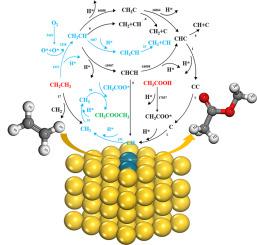当前位置:
X-MOL 学术
›
Mol. Catal.
›
论文详情
Our official English website, www.x-mol.net, welcomes your feedback! (Note: you will need to create a separate account there.)
Generation mechanism of methyl acetate during gas-phase synthesis of vinyl acetate from ethylene on PdAu(100) surface: A combined DFT and kMC study
Molecular Catalysis ( IF 4.6 ) Pub Date : 2024-04-06 , DOI: 10.1016/j.mcat.2024.114102 Minhua Zhang , Peng Zheng , Jiaqi Li , Yingzhe Yu
Molecular Catalysis ( IF 4.6 ) Pub Date : 2024-04-06 , DOI: 10.1016/j.mcat.2024.114102 Minhua Zhang , Peng Zheng , Jiaqi Li , Yingzhe Yu

|
Methyl acetate is a byproduct that is difficult to completely remove in the gas-phase process of producing vinyl acetate from ethylene. High-quality vinyl acetate products require stringent control of the methyl acetate content. However, studies on the mechanism of methyl acetate formation have not been reported, which constrains the modification of catalysts to reduce its formation. This paper presents a comprehensive study on the generation mechanism of methyl acetate during the ethylene-based vinyl acetate synthesis process over PdAu catalysts, utilizing a combination of DFT (Density Functional Theory) and kMC (kinetic Monte Carlo) simulations. The reaction network for the formation of methyl acetate on PdAu catalysts was constructed. Initially, DFT calculations were employed to investigate the adsorption properties of relevant species on the PdAu(100) surface. The results indicate that surface species preferentially adsorb at the Pd-Au bridge sites, diagonal Pd-Pd hollows, and diagonal Pd-Au hollows on the PdAu(100) catalyst, with a stronger interaction between the Pd atoms and the adsorbed species. Subsequently, DFT calculations were performed to identify the optimal pathways for the generation of methyl acetate on PdAu(100). Based on the kinetic parameters obtained from DFT calculations, kMC simulations were conducted to stimulate the generation process of methyl acetate. The results demonstrate that the dominant pathway for the formation of methyl acetate during the ethylene-based vinyl acetate synthesis over PdAu(100) is through . The reaction between CHCOO* and CH* to form methyl acetate is identified as the rate-determining step, with an energy barrier of 1.75 eV and an exothermic reaction heat of −0.53 eV.
中文翻译:

PdAu(100)表面乙烯气相合成乙酸乙烯酯过程中乙酸甲酯的生成机理:DFT和kMC的联合研究
乙酸甲酯是乙烯生产乙酸乙烯酯气相过程中难以完全除去的副产物。高品质的醋酸乙烯产品需要严格控制醋酸甲酯的含量。然而,关于乙酸甲酯形成机理的研究尚未见报道,这限制了催化剂的改性以减少其形成。本文结合 DFT(密度泛函理论)和 kMC(动力学蒙特卡罗)模拟,对 PdAu 催化剂上乙烯醋酸乙烯酯合成过程中乙酸甲酯的生成机理进行了全面研究。构建了 PdAu 催化剂上形成乙酸甲酯的反应网络。最初,采用DFT计算来研究相关物质在PdAu(100)表面上的吸附特性。结果表明,表面物质优先吸附在 PdAu(100) 催化剂上的 Pd-Au 桥位、对角 Pd-Pd 空心和对角 Pd-Au 空心处,Pd 原子与吸附物质之间的相互作用更强。随后,进行DFT计算以确定在PdAu(100)上生成乙酸甲酯的最佳途径。根据DFT计算得到的动力学参数,进行kMC模拟来模拟乙酸甲酯的生成过程。结果表明,在 PdAu(100) 上进行基于乙烯的乙酸乙烯酯合成过程中形成乙酸甲酯的主要途径是通过 。 CHCOO* 和 CH* 之间形成乙酸甲酯的反应被认为是速率决定步骤,其能垒为 1.75 eV,放热反应热为 -0.53 eV。
更新日期:2024-04-06
中文翻译:

PdAu(100)表面乙烯气相合成乙酸乙烯酯过程中乙酸甲酯的生成机理:DFT和kMC的联合研究
乙酸甲酯是乙烯生产乙酸乙烯酯气相过程中难以完全除去的副产物。高品质的醋酸乙烯产品需要严格控制醋酸甲酯的含量。然而,关于乙酸甲酯形成机理的研究尚未见报道,这限制了催化剂的改性以减少其形成。本文结合 DFT(密度泛函理论)和 kMC(动力学蒙特卡罗)模拟,对 PdAu 催化剂上乙烯醋酸乙烯酯合成过程中乙酸甲酯的生成机理进行了全面研究。构建了 PdAu 催化剂上形成乙酸甲酯的反应网络。最初,采用DFT计算来研究相关物质在PdAu(100)表面上的吸附特性。结果表明,表面物质优先吸附在 PdAu(100) 催化剂上的 Pd-Au 桥位、对角 Pd-Pd 空心和对角 Pd-Au 空心处,Pd 原子与吸附物质之间的相互作用更强。随后,进行DFT计算以确定在PdAu(100)上生成乙酸甲酯的最佳途径。根据DFT计算得到的动力学参数,进行kMC模拟来模拟乙酸甲酯的生成过程。结果表明,在 PdAu(100) 上进行基于乙烯的乙酸乙烯酯合成过程中形成乙酸甲酯的主要途径是通过 。 CHCOO* 和 CH* 之间形成乙酸甲酯的反应被认为是速率决定步骤,其能垒为 1.75 eV,放热反应热为 -0.53 eV。



























 京公网安备 11010802027423号
京公网安备 11010802027423号